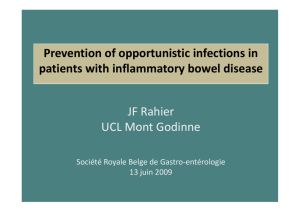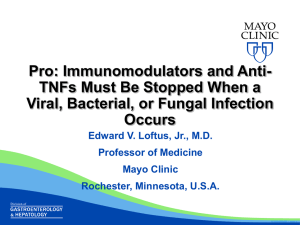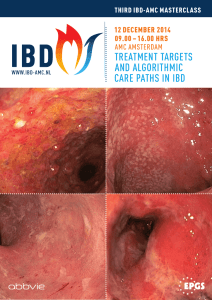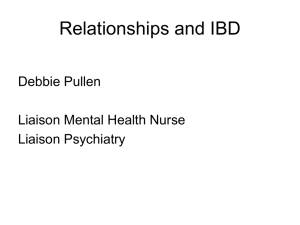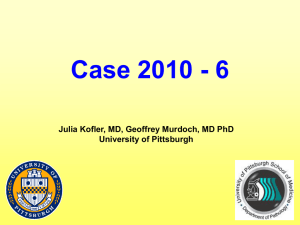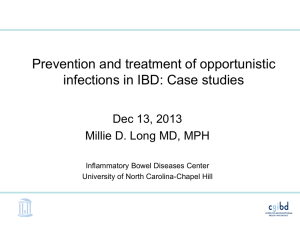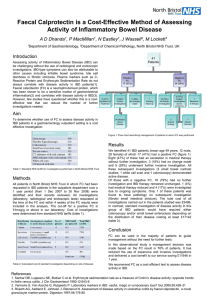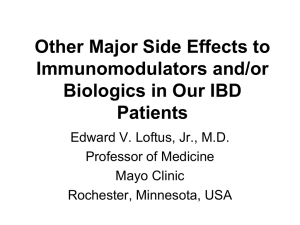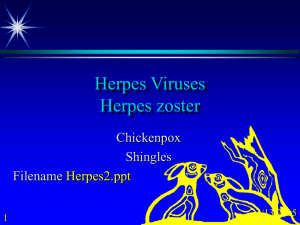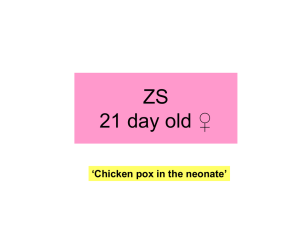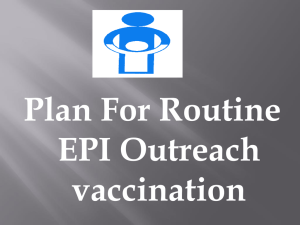Zoster vaccine - Advances in Inflammatory Bowel Diseases
advertisement
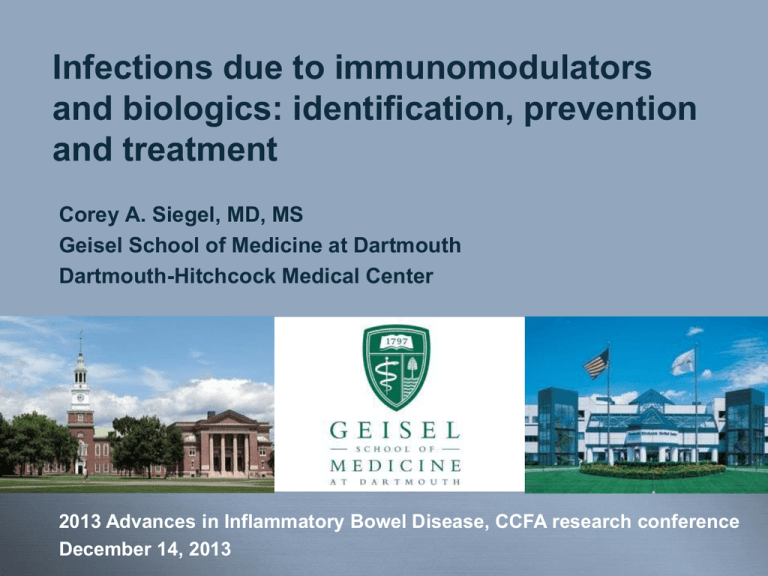
Infections due to immunomodulators and biologics: identification, prevention and treatment Corey A. Siegel, MD, MS Geisel School of Medicine at Dartmouth Dartmouth-Hitchcock Medical Center 2013 Advances in Inflammatory Bowel Disease, CCFA research conference December 14, 2013 Disclosures Consultant/Advisory Board Abbvie, BiolineRX, Given Imaging, Janssen, Salix, Millenium, Prometheus, Takeda, UCB Speaker for CME activities Abbvie, Janssen, Merck Grant support CCFA, NIH (K23DK078678), AHRQ (1R01HS021747-01) Abbvie, Janssen, Salix, Warner-Chilcott Slides available from me: corey.siegel@dartmouth.edu Infections in patients with IBD 1. How often and with what meds? 2. Does combination therapy make it worse? 3. Testing for TB…what to do if positive? 4. PML 5. Vaccinations, dead or alive! (NEW recs here) 6. Preventing and treating varicella zoster 3 How often do infections occur on our meds? COMMIT Infections SONIC Serious infections Pediatrics Serious infections MTX MTX + infliximab 58.7% 61.9% AZA Infliximab AZA + IFX 5% 2.5% 3.4% Anti-TNF IMs Steroids 3.5% 3.3% 7.3% Feagan et al. Digestive Disease Week, San Diego, CA 2008. Sandborn, WJ et al. ACG 2008. Dulai PS, et al. Inflamm Bowel Dis 2013. How often do life threatening infections occur on anti-TNF therapy? Reference Study Design # Deaths from sepsis thought attributable to infliximab # of Patients Ljung et al. Gut 2004 Population Based Cohort 1 191 Seiderer et al. Digestion 2004 Single-Center Cohort 0 92 Colombel et al. Gastroenterology 2004 Single-Center Cohort 5 500 Sands et al. NEJM 2004 Randomized Controlled Trial 2 282 Hanauer et al. Lancet 2002 Randomized Controlled Trial 1 573 Rutgeerts et al. Gastroenterology 1999 Randomized Controlled Trial 0 73 Risk of death from sepsis = 4/1000 pt-yrs Siegel et al. Clin Gastroenterol Hepatol. 2006;4:1017-1024. Who is at the most risk for dying from sepsis related to anti-TNF? »Older › Average age = 63 (systematic review); 67 (Mayo) »Multiple co-morbidities »Concomitant medications »Long-standing disease Young “healthy” patients are not in the clear, but probably less at risk Siegel, CGH 2006; Colombel, Gastro 2004; Lichtenstein CGH 2006 Are opportunistic infections more common if taking more than 1 medication? »Opportunistic infections Prednisone, 6MP/AZA, Infliximab Odds Ratio (95% CI) 1 medication 2.9 (1.5–5.3) 2 or 3 medications 14.5 (4.9–43) Lichtenstein CGH 2006; Toruner, Gastro 2008 Closer look at the Mayo experience with opportunistic infections Herpes zoster Candida albicans Herpes Simplex CMV EBV Histoplasmosis Blastomycosis Streptococcus E. Coli Mycobacterium marinum Mycobacterium fortuitum Cryptococcus Mycobacterium gordonae 28 26 18 12 8 2 1 1 1 1 1 1 1 Toruner et al. Gastro 2008;134:929 Closer look at the Mayo experience with opportunistic infections Number of meds 0 1 2 or 3 Specific combinations Corticosteroids alone 6MP/AZA alone IFX alone AZA/6MP + steroids AZA/6MP + IFX AZA/6MP + IFX + steroids Cases 38 38 24 16 20 3 16 1 5 Controls 129 59 12 27 31 2 6 5 0 OR 1.0 (ref) 2.9 (1.5-5.3) 14.5 (4.9-43) 2.2 (1.0-4.9) 3.4 (1.5-7.5) 11.1 (0.8-148) 17.5 (4.5-68) 1.6 (0.1-19) 1.1 (1.0-1.2) Toruner et al. Gastro 2008;134:929 Quality Measures for IBD »Both AGA and CCFA quality measures › HBV testing before initiating anti-TNF › Testing for latent tuberculosis before starting antiTNF (which method) › Influenza and pneumococcal vaccinations Siegel CA, Allen JI, Melmed GY. Clin Gastroenterol Hepatol 2013. Baseline testing prior to immune suppression »Testing for latent tuberculosis Quantiferon vs TST 40 35 % positive 30 25 20 15 10 5 0 No IS (IBD) IS (IBD) » QuantiFERON Gold is consistent despite immunosuppression or BCG status » Lower false positive » Single office visit » Cost effective » Recommended by CDC! TST (skin test) QuantiFERON Gold Disease activity may play a big role in indeterminate results of Quant-Gold Schoepfer, Am J Gastroenterol 2008; Diel, Chest 2007; Hradsky O et al. J Pediatri Gastroentenrol Nutr 2013. Epub ahead of print. If Tuberculosis Screening Test is Positive… » Quant Gold positive or skin test ≥ 5mm » Chest X-Ray » Work with ID experts » Before initiating anti-TNF, ideally treat for 6 months with INH, but not always practical – 2 months acceptable (sometimes concurrent needed with close follow) › INH 300mg PO qd x 6 months › INH + Rifampicin x 3 months (higher hepatitis risk) › +/- pyridoxine 50mg PO qd ECCO guidelines 2009; British Thoracic Society Standards of Care Committee. Thorax 2005;60:800. http://www.cdc.gov/tb/pubs/PDF/1376.pdf Natalizumab and PML Risk Based on anti-JC Virus Antibody Status Anti-JCV Antibody Status Negative < 0.11/1000 Positive (and prior IS use) 0-2 years 2/1000 (1 in 500) 2+ years 11/1000 (≈1 in 100) To ORDER anti-JC Virus antibody test: Quest Labs test # 90257, JC Virus Antibody with Reflex Inhibition Assay About 50% of Crohn’s patients will be positive Bloomgren, et al. NEJM 2012;366.20. General vaccination recommendations for immunosuppressed IBD patients »Annual influenza vaccination in IBD patients »Pneumococcal vaccination in IBD patients, repeat 5 years later »Consider vaccinating ALL susceptible IBD patients at diagnosis before immunosuppressed »NEW recommendations about LIVE vaccines The pneumonia vaccination(s) » Consider using “Combination therapy” » PPSV23 vaccine (polysaccharide) should be given to ALL patients (high, low or planned immune suppression) and once 5 years later » PCV13 (conjugated – super booster) vaccine should be give to all patients with current or planned immune suppression › at least 8 weeks before or at least 1 year after PPSV23 vaccine) Vila-Corcoles A, Ochoa-Gondar O. Drugs Aging 2013; Rubin, LG, et al. Clinical Infectious Diseases, December 2013 Will the vaccinations work in immunosuppressed IBD patients? » IBD patients receiving pneumovax, tetanus, influenza and HIB on azathioprine/6MP monotherapy had a normal response to vaccinations » Adult IBD patients receiving pneumococcal vaccine had poor response if on combination anti-TNF + immunomodulator therapy » Pediatric IBD patients receiving influenza vaccine had a poor response if on combination anti-TNF + immunomodulator therapy » In patients with juvenile systemic lupus, main predictor of LACK of response was a higher disease activity (not immune suppression) Dotan, Gastroenterology 2007;132(4):A-51. Lu, Am J Gastroenterol 2009. Melmed, DDW 2008. Mamula CGH 2007;5(7):851. Campos LM, et al. Arthritis Care Res 2013 Risk of Herpes Zoster (“shingles”) is increased in IBD »Case control study, GPRD 1988-1997 › 7823 (Crohn’s), 11,930 (UC), and 79,563 (control) »Incidence of HZV is about 1.5x higher in IBD »Risk increases with immunosuppression › Corticosteroids OR 1.5 (1.1 – 2.2) › AZA/6MP OR 3.1 (1.7 – 5.6) Gupta, Lautenbach, and Lewis. Gastroenterology 2006 Zoster in IBD increases with Age Long et al. Alim Pharm Ther 2013 Varicella and Zoster vaccines in immune suppressed patients » Varicella vaccination safe and effective in children with HIV » Pediatric IBD patients from Boston Children’s varicella vaccination in immunosuppressed kids was safe and effective » 463,541 Medicare beneficiaries with various inflammatory disorders (subgroup on biologics) › No cases of HZV infection in biologic-treated patients who received Zoster vaccine › Zoster Vaccine was protective HR 0.61 (95% CI, 0.52-0.71) Taweesith W. et al. Pediatr Infect Dis J 2011; Lu Y, Bousvaros A. J Pediatr Gastroenterol Nutr 2010; Zhang et al. JAMA 2012 2013 Infectious Disease Practice Guidelines HOT off the press (12/4/13) » Differentiate “low-level” from “high-level” immune suppression › Low-level = prednisone ≤ 20mg/kg/day, AZA ≤ 3.0mg/kg, 6MP ≤ 1.5mg/kg, MTX ≤ 0.4mg/kg/wk › High-level = prednisone > 20mg, higher doses azathioprine, 6MP, MTX or ANY biologic » Varicella vaccine (if not immune) › NO for high-level › Maybe for low-level (CDC disagrees) » Zoster vaccine › NO for high-level › YES for low-level if > 50 years old (or younger if history of varicella) Rubin, LG, et al. Clinical Infectious Diseases, December 2013 Other pearls from the IDSA Guidelines »How long do you have to wait to start immune suppression after a live virus vaccine? › At least 4 weeks »NEVER give live influenza*, MMR or yellow fever if immune suppressed »Household contacts › CAN receive: MMR, rotavirus for infants, Varicella/Zoster (but watch for lesions) , yellow fever, oral typhoid › CANNOT receive: live influenza, live polio Rubin, LG, et al. Clinical Infectious Diseases, December 2013 What if your patient gets it? Shingles is very different than disseminated varicella 22 Treating Varicella in Immunosuppressed Patients » Zoster (Shingles) › Treat within 1 week of onset (or before full crusting of lesions) › Localized disease valacyclovir, acyclovir, famcyclovir › Disseminated zoster (or severely immunosuppressed) IV acyclovir » Chickenpox › Oral or IV antiviral treatment Ahmed, Herpes 2007;14(2):32. CDC recommendations, Available at: http://www.cdc.gov/vaccines/vpd-vac/varicella/dis-faqs-gentreatment.htm Post-Exposure Prophylaxis -Varicella (chickenpox & shingles)» What constitutes exposure? › Chickenpox Close indoor contact, face-to-face contact › Shingles Contact with open lesions » Are they susceptible? › Negative history of disease, no vaccination, negative titers » If not immunosuppressed › Vaccination within 3-5 days of exposure » If immunosuppressed › Within 96 hrs Varicella zoster immune globulin (VariZIG) › Later than 96 hrs Consider IVIg › Limited data on acyclovir Centers for Disease Control and Prevention (CDC). Available at: http://www.cdc.gov/vaccines/vpd-vac/varicella/vac-faqs-clinic-highrisk.htm. Centers for Disease Control and Prevention (CDC). MMWR Morb Mortal Wkly Rep 2006; 55(8): 209–10. Asano, Pediatrics 1993; 92(2): 219–22. Summary » We are never going to prevent all infections » But, we have an opportunity to prevent serious infectious complications by thoughtful patient selection and vaccination » We still have more to learn about vaccinations (particularly live vaccinations and anti-TNF) » Critical to have early recognition and treatment of infections in immunosuppressed patients (lower threshold for intervention) Slides available from me: corey.siegel@dartmouth.edu
